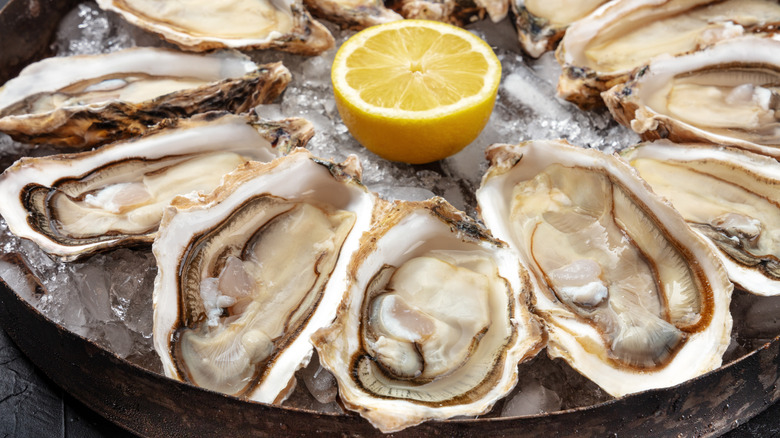It's Actually Safe To Eat Oysters In July
It seems like every time you tap into social media during the summer months, someone has posted a photo enjoying chilled oysters over ice. It's the ultimate summer snack, plus the salty ice bed these raw shellfish sit on looks nothing short of photogenic. But in the history of oysters, we have always heard it's not safe to eat them during the summer months. Why is this? The answer is a bit complicated, but there is one bottom line: As long as you're smart about where and when you consume them, it's perfectly safe to enjoy fresh oysters in July.
The two big reasons people don't always eat oysters in summer are that they can potentially harbor harmful bacteria, and the oysters tend to reproduce during that time, which affects their taste. But most oyster farms are in cold Northeast waters, and oyster farmers are careful and follow strict guidelines about producing good-quality shellfish. While there is technically still a chance of illness, it's more about educating yourself than avoiding oysters altogether. Make sure to avoid common mistakes with oysters, eat them fresh, trust where you buy them, and toss them if they have any concerning signs of spoilage.
It's safe to eat oysters during summer
Fresh oysters used to be less popular in the summer months because that's when the shellfish reproduce, which could change their flavor and texture. Plus, waters are warmer in summer, and oysters in too-warm waters, or exposed to too much heat or red tide, can be unsafe to eat. However, times have changed now that most United States oysters are farmed.
Rowan Jacobsen, author of "Geography of Oyster Farmers" told The Kitchn that these days, oysters can be bred to be sterile, which means there is no concern about their flavor changing in the summertime due to reproduction. Plus, there are processes in place for oyster farmers to regularly test the water in which their oysters are growing, which avoids concern of dangerous bacteria levels.
"Oysters have to be refrigerated the moment they come out of the water, and stored at that temperature all the way to your plate, so safety is less of an issue," Jacobsen added. "[The] whole industry has more knowledge and awareness of handling." Surprisingly, you'll never find imported oysters from the European Union; oyster harvesting is so strict in the United States, and with less-strict rules in the EU, importation isn't allowed.
Be smart about eating oysters in the summer
While there is certainly less of a safety risk than there used to be, it's still important to be vigilant when consuming fresh, uncooked seafood. Oysters harvested in cold water are generally safer than those harvested in warm places during the summer, such as the Gulf of Mexico. In 2018, USA Today reported that a Texas woman died after consuming raw oysters that she purchased in Louisiana; the Centers for Disease Control says Vibrio, the bacteria that causes Vibriosis and led to the woman's death, is commonly transmitted to humans through raw seafood found in warm water temperatures.
Keep an eye on where your oysters are coming from. Cold waters tend to have a lower risk of high bacteria levels, so if you have any concerns, look for oysters harvested from New England or the Pacific Northwest. Make sure the oysters have always been kept either refrigerated or on ice; do not purchase them if they've been sitting out. And when you do buy them, eat them right away. They should not be eaten more than a week after being harvested in the summer, or 10 days in the winter — so be sure you know the harvest date.


